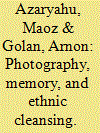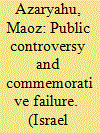| Srl | Item |
| 1 |
ID:
091089


|
|
|
|
|
| Publication |
2009.
|
| Summary/Abstract |
In the spring of 2009 Tel-Aviv celebrated its centennial with festive events and inauguration ceremonies of long due public projects, TV documentaries, academic conferences in Israel and abroad, albums, and anthologies. The idea of devoting a special issue of Israel Studies to Tel-Aviv on the occasion of its centennial appears self-evident: it is a truism that Tel-Aviv occupies a special place in the history and geography of modern Zionism and Israel. The anniversary is a convenient pretext, for it does not appear that 2009 represents a watershed in the political, social, economic, urban, or cultural history of Tel-Aviv.
|
|
|
|
|
|
|
|
|
|
|
|
|
|
|
|
| 2 |
ID:
112532


|
|
|
|
|
| Publication |
2012.
|
| Summary/Abstract |
Much of the recent academic literature on the 1948 war portray it a one-sided-and thus simplistic-ethnic cleansing of the Arab population of Palestine. Referred to as the Naqba paradigm, it features the Jews/Zionists as villainous perpetrators and the Palestinian Arabs as feeble victims. Accordingly, the story of "the 1948 Ethnic Cleansing of Palestine" excludes expulsion and massacres of Jews, the destruction of Jewish communities, and the erasure of the Jewish signifiers in the local landscape from the story. As made explicit in John Phillips' photo-reportage featuring the destruction of the Jewish Quarter of the Old City of Jerusalem, the ethnic cleansing of Palestine also involved the expulsion of Jews and the destruction of their communities-whenever and wherever military power relations were in favor of Arab forces.
|
|
|
|
|
|
|
|
|
|
|
|
|
|
|
|
| 3 |
ID:
102737


|
|
|
|
|
| Publication |
2011.
|
| Summary/Abstract |
Drawing on the academic literature on public art conflicts and public memory controversies, the article examines the controversy over the design for Tel-Aviv's Monument to the Holocaust and National Revival, and its failure to perform its commemorative function. It argues that underlying the controversial character of the design and the failure of the monument to perform its commemorative function was a public art conflict: the abstract design selected for the monument elicited public opposition as unfitting to represent the monument's commemorative theme.
|
|
|
|
|
|
|
|
|
|
|
|
|
|
|
|
| 4 |
ID:
091090


|
|
|
|
|
| Publication |
2009.
|
| Summary/Abstract |
The article explores three successive anniversary celebrations of Tel-Aviv-1929, 1934, and 1959-as an aspect of the cultural and political history of the city. The three anniversaries examined in this paper were celebrated in the "First Hebrew City" phase of the cultural history of Tel-Aviv and, accordingly, their major theme was Tel-Aviv as a Zionist success story. The historical analysis of three successive anniversaries affords an opportunity to discern continuities in the form of festive patterns and recurrent ideological themes. It also highlights period-specific concerns and political contingencies underlying particular anniversary celebrations.
|
|
|
|
|
|
|
|
|
|
|
|
|
|
|
|